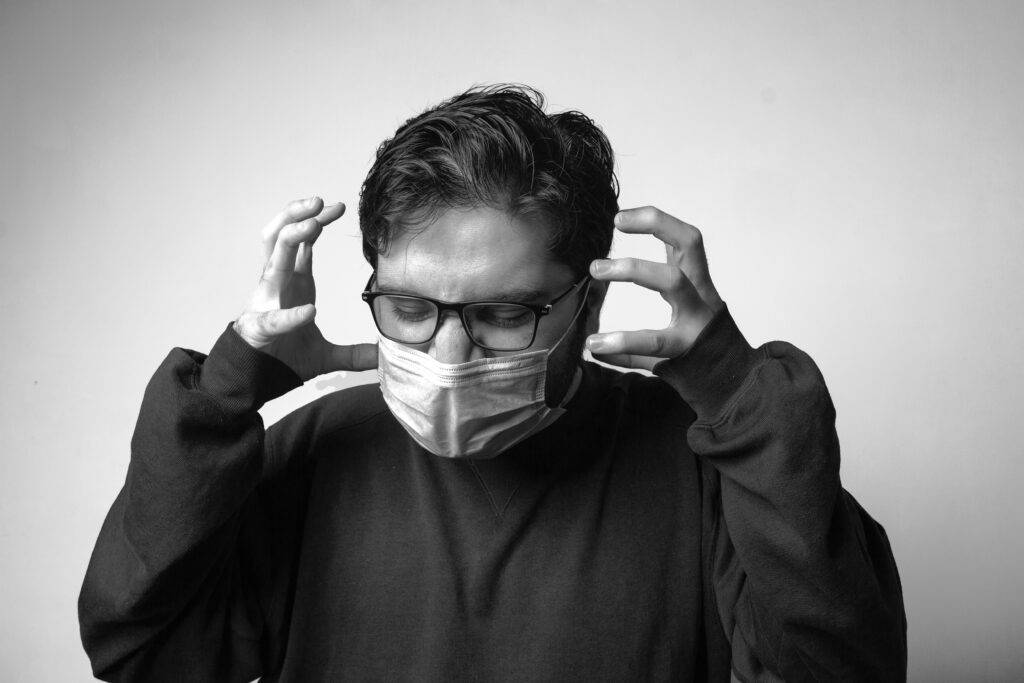A migraine is characterized by a stabbing pain on one side of the head. It can include symptoms of moderate or severe headaches. In addition, other symptoms include feeling sick and suffering from hypersensitivity to light or sound.
It is estimated that one in five women and one in fifteen men suffer from migraines on a regular basis. So, these episodes of intense pain usually appear in early adulthood.
Remember, this article is for informational purposes. At no time can it provide an accurate diagnosis or allow patients to self-diagnose. So, the indicated thing is to go to professional medical attention to provide more certainty to the case.
Migraine and other types of headaches
- Migraine with aura: it is a recurrent pain where it is possible to see flashing lights before the migraine or at the same time. It can include tingling in the face and an increased chance of having a stroke.
- Migraine without aura: the most common type of migraine. It has no specific warning signs, just pain. Later you may experience nausea and vomiting.
- Silent migraine: An aura or other migraine symptoms are present, but there is no headache.
Some people may have several migraines a week and others only get them occasionally. It is also possible to go years without experiencing a migraine attack.
When should you seek medical attention for a migraine attack?

Call an ambulance if you or someone else experiences the following symptoms:
- Paralysis or weakness of one arm or one side of the face
- Distorted or slurred speech
- Sudden severe pain in the form of a severe headache
- Acute headache
- High temperature (fever)
- Neck stiffness
- Mental confusion
- Seizures
- Double vision
- Rash
See your doctor as soon as possible, as these symptoms may indicate a more serious medical complication, such as a stroke or meningitis.
A doctor should check for migraine symptoms that are frequent or severe.
Migraines can usually be treated with simple pain relievers, such as acetaminophen or ibuprofen. However, it can be more difficult to treat these pains over time if you get used to using the maximum dose of pain relievers.
You should see your GP when you have frequent migraines (more than five days a month) even if you control them with medication. Preventive treatment can bring more benefits.
What causes migraine?
There is no exact cause to account for migraines. However, chemicals in the brain, nerves, and blood vessels are thought to undergo temporary changes, and this is demonstrated by the body through pain.
There is also evidence that genes may play a role in migraines. It is estimated that about half of those affected have a close relative with the same condition.
Certain factors triggers migraine attacks:
- Menstruation
- Stress
- Fatigue
- certain diet
How to eradicate migraine? Treatment and measures

There are treatments available to help reduce migraine symptoms, but there is no cure to completely eradicate it.
Medications that reduce migraine:
- Pain relievers: paracetamol and ibuprofen, available without a prescription.
- Triptans: help reverse the brain changes that cause migraines. Some are sumatriptan, naratriptan, zolmitriptan, eletriptan, almotriptan, frovatriptan, and rizatriptan
- Antiemetics: Helps nausea and vomiting. Some are metoclopramide, domperidone, and ondansetron.
- Sleep in a dark and quiet room.
How to prevent migraine attacks?
If you suspect that your migraines are caused by a specific trigger (stress or a certain type of food), it may help to avoid that trigger, to begin with.
Try to maintain a healthy lifestyle: exercise regularly, sleep and eat well, and limit your intake of caffeine and alcohol.
Your doctor may prescribe medication to prevent your migraine attacks if they’re severe or if removing your potential triggers isn’t effective. One of them is Propranolol, which is commonly used for high blood pressure and migraines.
With prevention, your migraine symptoms may improve for periods of several weeks.
Your quality of life vs your migraines

A migraine can cause a quality of life where you cannot carry out a normal routine. You could even spend days in bed.
The symptoms can be reduced with various treatments, but the ideal would be to prevent new attacks. It’s about gradually getting better, not getting worse over time and learning to live with it.
Medications are only part of the solution to migraines. The best way to cope with a migraine is to preserve your health. This will help reduce the frequency and severity of a migraine.
A change in lifestyle could bring you more benefits than the disappearance of a migraine.
Take breaks in a quiet place
At the first sign of a migraine, it is best to stop what you are doing and take a break.
Turn off the lights and find a moment of silence. Remember the hypersensitivity of migraine. Take a deep breath and relax in a dark, quiet room. If you can, take a nap.
Remember that this is not an excuse to be lazy, if you have a migraine and force yourself to work, it will be detrimental to your performance and well-being.
End your day with a relaxing massage, calming music, a warm bath, or reading your favorite book to promote better sleep.

Temperature therapy
Put a hot or cold compress on your head or neck. It can have a numbing effect and reduce the perception of pain.
Tight muscles are relaxed with hot compresses and heating pads. You can do something similar by taking a warm shower or bath.
Are caffeinated drinks good for migraines?
Aspirin and acetaminophen can reduce migraine pain in small doses. Caffeine can do something similar, however, be careful with the measure.
Caffeine withdrawal headaches are caused by drinking too much caffeine on a regular basis. Also, if you ingest caffeine in the afternoon or at night, it could interfere with your sleep and cause migraines.
A good night’s sleep
You could sleep poorly because the migraine does not let you sleep, which can bring about a vicious circle between insomnia and headache. Here are some tips to encourage sound sleep.
Sleep on a regular schedule: make it a point to go to bed and wake up at the same time every day, no matter what day it is. If you do take naps, they should be in the 20-30 minute range, or you could affect your night’s sleep.
Don’t eat or drink too much before bed. Your sleep is impaired by intense exercise, large meals, caffeine, nicotine, and alcohol.
You must keep distractions to a minimum. Keep work, entertainment, and, above all, worries away. Close your bedroom and escape from the noises of your environment.
In time, sleeping shouldn’t be so difficult. In the meantime, do something that makes you sleepy.
Check your medications. Some can interfere with your sleep if they contain caffeine or other stimulants.
Choose your eating habits

Migraines depends of what you eat.
You have to consider some basic concepts:
- Stay consistent in your meal times and what you eat.
- Fasting and fasting is the worst thing you can do for your migraine, especially if you don’t have a nutritionist to help you with that eating plan.
- Keep a food diary. There you can record if you found triggers for your migraine.
- Eliminate those triggers from your diet: aged cheese, chocolate, caffeine, and alcohol, among others.
Do an exercise routine
When you exercise, a series of chemicals in your body are released and prevent pain from reaching your brain.
In addition to relieving your migraine symptoms, these chemicals can also relieve anxiety and depression.
Chronic headaches are associated with obesity. All of these health chart (exercising, eating well, sleeping well) will help you manage migraines and stay healthy.
Choose an exercise that your doctor approves. Often the ideal is to walk, swim or ride a bike. Do this gradually, as it could intensify your migraine if you decide to do very vigorous exercise from one day to the next.
Stress management to reduce migraine
Migraines and stress often go hand in hand.
Seek to live a simpler life. Avoid packing more activities into your day than you can handle. Leave everything that is not necessary to do on that day.
Learn to manage your time. Keep a to-do list. Also, make your projects manageable by delegating as much as you can.
When you feel overwhelmed, take a brisk walk or stretch. Remember to rest and keep a positive attitude. Change from “This is not possible” to “I can do it”.
Also, try to spend at least 15 minutes each day doing something you enjoy. Play video games, have coffee or spend time with a friend or do a hobby. You can reduce stress naturally when you do something you enjoy.
Do breathing exercises and relax your muscles. You can take a yoga class or just take a moment to sit quietly after work. Then learn to meditate
Make a migraine diary

You can determine the cause and triggers of your migraines when you keep a diary where you record your headaches. Write down when your migraines start, what you were doing at the time, how long they last, and what gives you relief.
By using behavior management techniques, you may be able to cope with pain triggers.
It would also be helpful in challenging negative thoughts, practicing relaxation techniques, and reducing stress. However, this is another alternative method, it needs a deeper study. So, trust only your doctor.
Balance is key
Migraine is a daily challenge and can be the same cause of stress and migraine. However, choosing a healthy lifestyle can help.
Consider asking loved ones for help, joining a support group, and seeking counseling. It can help you if you feel anxious or depressed.
Take control of pain by believing in yourself and continue reading with us about your health:


